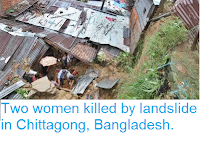Seven people have been confirmed dead and about 150 are still missing after Cyclone Mora made landfall in eastern Bangladesh on Tuesday 30 May 2017. The cyclone caused widespread flooding in Chittagong and Cox's Bazar districts, washing away many homes in low lying areas. Coastal communities and Rohingya refugees living in camps close to the border with Myanmar are thought to have been the worst hit. Most of the missing people are fishermen caught at see by the storm; ships from the Indian and Bangladeshi navies are searching for survivors.
Damaged homes in Cox'x Bazar district following Cyclone Mora. Munir Uz Zaman/Reuters.
Tropical
storms are caused by solar energy heating the air above the oceans,
which causes the air to rise leading to an inrush of air. If this
happens over a large enough area the inrushing air will start to
circulate, as the rotation of the Earth causes the winds closer to the
equator to move eastwards compared to those further away (the Coriolis
Effect). This leads to tropical storms rotating clockwise in the
southern hemisphere and anticlockwise in the northern hemisphere.These
storms tend to grow in strength as they move across the ocean and lose
it as they pass over land (this is not completely true: many tropical
storms peter out without reaching land due to wider atmospheric
patterns), since the land tends to absorb solar energy while the sea
reflects it.
Damage to homes in the Balukhali Refugee Camp in Cox's Bazar, Bangladesh, following Cyclone Mora. Mohammad Pamir/Rueters.
See also...






